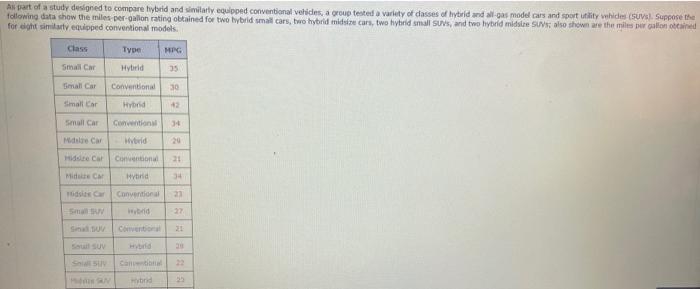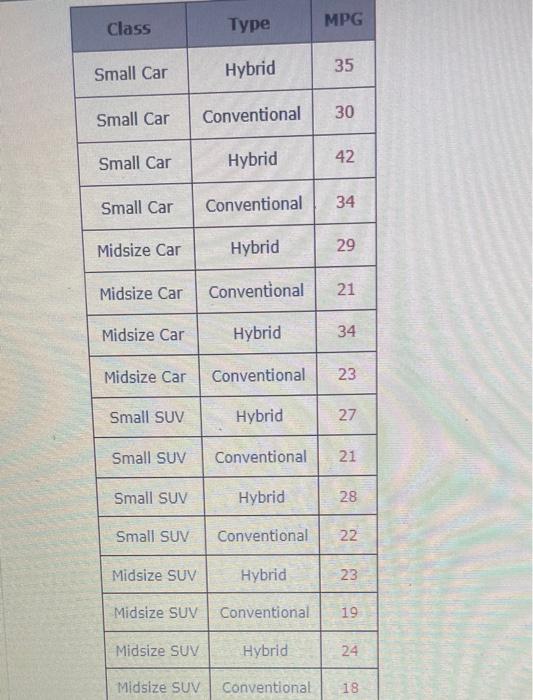for dight sin isty equipped conventional models: \begin{tabular}{|l|c|c|} \hline Class & Type & MPG \\ \hline Small Car & Hybrid & 35 \\ \hline Small Car & Conventional & 30 \\ \hline Small Car & Hybrid & 42 \\ \hline Small Car & Conventional & 34 \\ \hline Midsize Car & Hybrid & 29 \\ \hline Midsize Car & Conventional & 21 \\ \hline Midsize Car & Hybrid & 34 \\ \hline Midsize Car & Conventional & 23 \\ \hline Small SUV & Hybrid & 27 \\ \hline Small SUV & Conventional & 21 \\ \hline Small SUV & Hybrid & 28 \\ \hline Small SUV & Conventional & 22 \\ \hline Midsize SUV & Hybrid & 23 \\ \hline Midsize SUV & Conventional & 19 \\ \hline Midsize SUV & Hybrid & 24 \\ \hline Midsize SUV & Conventionat & 18 \\ \hline \end{tabular} the =0.05 level of significance, test for significant effects due to class, type, and interaction. ind the value of the test statistic for dass. (Round your answer to two decimal places.) Find the p-value for dass. (Round your answer to three decimal places.) p-value = State your condusion about class. Because the p-value =0.05, class is not significant. Because the p-value >=0.05, class is not significant. Because the p-value >=0.05, class is significant. Because the p-value a=0.05, class is significant. Find the value of the test statistic for type. (Round your answer to two decimal places.) Find the p-value for type. (Round your answer to three decimal places.) p-value = State your conclusion about type. Because the p-value >=0.05, type is not significant. Because the p-value =0.05, type is not significant. Because the p value >0.05, type is significant. Because the p-value a =0.05, type is significant. Find the value of the test statistic for interaction between class and type. (Round your answer to two decimal places.) nd the value of the test statistic for type. (Round your answer to two decimal places.) ind the p-value for type. (Round your answer to three decimal places.) -value = State your conclusion about type. Because the p-value >a=0.05, type is not significant. Because the p-value =0.05, type is not significant. Because the p-value >a=0.05, type is significant. Because the p-value a=0.05, type is significant. Find the value of the test statistic for interaction between class and type. (Round your answer to two decimal places.) Find the p-value for interaction between class and type. (Round your answer to three decimal places.) p-value = State your conclusion about interaction between class and type. Because the p-value >=0.05, interaction between class and type is not sionificant. Because the p-value sa=0.05, interaction between class and type is not significant. Because the p-yalue >a=0.05, interaction between class and type is significant. Because the p-value s=0.05, interaction between class and tvpe is sionificant. for dight sin isty equipped conventional models: \begin{tabular}{|l|c|c|} \hline Class & Type & MPG \\ \hline Small Car & Hybrid & 35 \\ \hline Small Car & Conventional & 30 \\ \hline Small Car & Hybrid & 42 \\ \hline Small Car & Conventional & 34 \\ \hline Midsize Car & Hybrid & 29 \\ \hline Midsize Car & Conventional & 21 \\ \hline Midsize Car & Hybrid & 34 \\ \hline Midsize Car & Conventional & 23 \\ \hline Small SUV & Hybrid & 27 \\ \hline Small SUV & Conventional & 21 \\ \hline Small SUV & Hybrid & 28 \\ \hline Small SUV & Conventional & 22 \\ \hline Midsize SUV & Hybrid & 23 \\ \hline Midsize SUV & Conventional & 19 \\ \hline Midsize SUV & Hybrid & 24 \\ \hline Midsize SUV & Conventionat & 18 \\ \hline \end{tabular} the =0.05 level of significance, test for significant effects due to class, type, and interaction. ind the value of the test statistic for dass. (Round your answer to two decimal places.) Find the p-value for dass. (Round your answer to three decimal places.) p-value = State your condusion about class. Because the p-value =0.05, class is not significant. Because the p-value >=0.05, class is not significant. Because the p-value >=0.05, class is significant. Because the p-value a=0.05, class is significant. Find the value of the test statistic for type. (Round your answer to two decimal places.) Find the p-value for type. (Round your answer to three decimal places.) p-value = State your conclusion about type. Because the p-value >=0.05, type is not significant. Because the p-value =0.05, type is not significant. Because the p value >0.05, type is significant. Because the p-value a =0.05, type is significant. Find the value of the test statistic for interaction between class and type. (Round your answer to two decimal places.) nd the value of the test statistic for type. (Round your answer to two decimal places.) ind the p-value for type. (Round your answer to three decimal places.) -value = State your conclusion about type. Because the p-value >a=0.05, type is not significant. Because the p-value =0.05, type is not significant. Because the p-value >a=0.05, type is significant. Because the p-value a=0.05, type is significant. Find the value of the test statistic for interaction between class and type. (Round your answer to two decimal places.) Find the p-value for interaction between class and type. (Round your answer to three decimal places.) p-value = State your conclusion about interaction between class and type. Because the p-value >=0.05, interaction between class and type is not sionificant. Because the p-value sa=0.05, interaction between class and type is not significant. Because the p-yalue >a=0.05, interaction between class and type is significant. Because the p-value s=0.05, interaction between class and tvpe is sionificant










